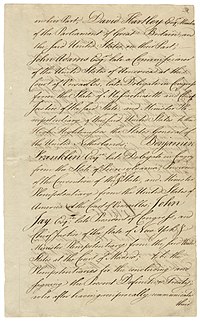Treaty of Kien-k'ang
| Treaty of Perpetual Friendship Between Hallia and Themiclesia | |
|---|---|
 Page 3 of the treaty | |
| Type | Alliance, tariff, mineral rights |
| Context | Second Maverican War |
| Signed | February 2, 1796 |
| Location | Kien-k'ang, Themiclesia |
| Parties |
|
| Language | Hallian, Shinasthana |
The Treaty of Kien-k'ang was an international treaty between Hallia and Themiclesia signed on Feb. 2, 1796. In the last quarter of 18th century, Themiclesia was involved in simultaneous disputes over the Columbian subcontinent with Anglia and Lerchernt and Camia, while relations with Hallia were comparatively stable. In 1791, Themiclesian-controlled Norfeld rebelled with the support of Maverica, which was further backed by Ostland, and a considerable deployment from Camia. The largest part of Themiclesia's fleet was burnt down in the Raid on Rad in 1791, which rendered her incapable of tending to subcontinental interests, and Hallia viewed Themiclesia's difficulties as an opportunity to eliminate it as an actor on the subcontinent. Using the merchant marine, Themiclesia sought to open a new front with Camia to force their withdrawal from Norfeld, ultimately to no success. Due to widespread and badly-managed conscription, the Themiclesian economy buckled, resulting in regional famines and general political discontentment, particularly from the aristocracy. In 1795, Hallia proposed a treaty favourable to themselves and appeared with a fleet near Themiclesia to compel its acceptance, which was ratified on Feb. 2, 1796.
The treaty contained several provisions favourable to Hallia, reflecting rushed negotiation from a poor position on Themiclesia's part. First, Themiclesia ceded the prefectures of Sngrak-pjang, Ts′jeng-gar, m-Legh, and Rjaw to Hallia, which is today part of Nukkumaa; around a half-million Themiclesians lived in these prefectures. Second, Themiclesia conferred mineral monopolies north of the River Pjem to Hallia for 100 years. Third, the rivers Pjem and Lut were open to Hallian commercial vessels, mostly for the extraction of minerals in the area. Fourth, Hallia warships were to be granted basing rights in Themiclesia. Fifth, the Isle of Krjang and numerous others in the Halu'an Sea were ceded to Hallia. In return, Themiclesia received a sizeable loan to balance its books and finish the war in Norfeld, and Hallia mobilized its troops to apply pressure on Camia to withdraw their troops from Norfeld.
In Themiclesia, the treaty generated mixed feelings that changed according to prevailing social views. At signing, the treaty was regarded as a success or at least a relief. Aristocrats that were heavily taxed to finance the war welcomed the treaty; on the other hand, certain sectors of merchants that were dependent on Themiclesia's residual control over Columbia and Norfeld found the treaty unsatisfactory, since they contained no provisions about these more remote interests. The greatest opposition to the treaty came from the residents of the prefectures ceded, who believed the government had made them homeless, even though resettlement was in progress. Nevertheless, the treaty was regarded positively by the Conservative Party that primarily wished to reduce government expense and taxation to support it. In later ages, however, the Liberal Party used it as a warning that poor position was a threat to domestic tranquility, in combination with the reminder that a portion of Themiclesian minerals were deferred to Hallia.
On Mar. 5, 1897, mineral rights north of the River Pjem reverted to Themiclesia. The Conservative prime minister, the Lord of Krungh, sent letters of gratitude to the Hallian government for keeping to the terms of the treaty. Parts of the treaty, namely the allowal of Hallian warships to dock in Themiclesia and commercial ships to travel on the Rivers Pjem and Lut, remain in force today.